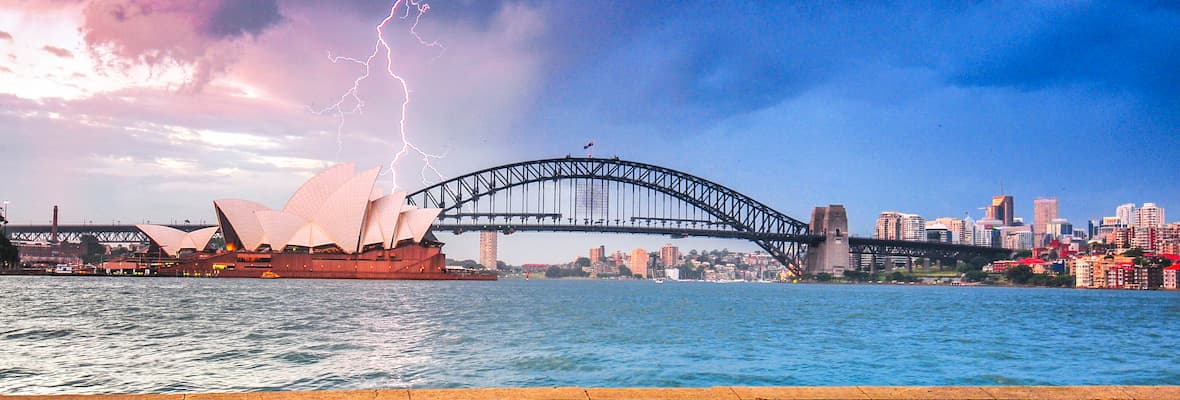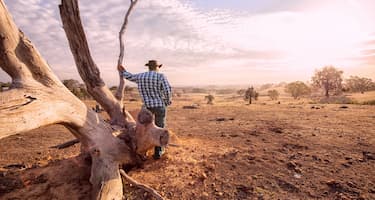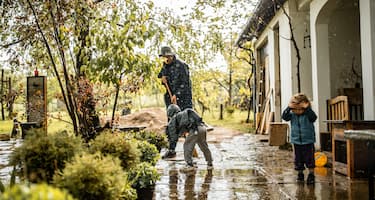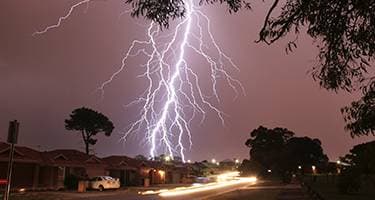From making sure you’re safe and prepared, to protecting your belongings from damage, storm season can be a stressful time.
But how do Australians prepare, and are they doing enough? To uncover some of the attitudes, beliefs and behaviours surrounding storm season, Budget Direct surveyed more than 1,000 Australians aged 18 and over on how severe weather affects them.
We also compared these results to Budget Direct’s Australian Storm Survey and Statistics 2021 to understand how annual trends and attitudes are changing over time.
Quick Stats
65% of those surveyed don’t have an action plan in place in case of a severe storm.
18% of Australians surveyed aren’t sure what’s included in their home insurance policy to cover them if their home is made uninhabitable due to a storm.
Less than one in five Australians surveyed cleaned their gutters the recommended frequency or more.
More than a quarter of Australians surveyed aren’t sure who would be liable in certain storm-related insurance claims.
Australian Storm Statistics
In Australia, there’s a range of extreme storm events that can pose a risk to your home, including:
Flooding
Heavy wind
Heavy rain
Cyclones
Tornadoes
Australia has experienced its fair share of severe weather events from flooding to bushfires. However, when it comes to the total insurance cost of these catastrophes, storm-related events top the list of being the most expensive.
In fact, flooding, hail storms, rain events and cyclones made up eight of the ten biggest insurance catastrophes in Australia’s history. [1]
Ten Biggest Insurance Catastrophes in Australia to 2023
Catastrophe |
Cost (adjusted for inflation) |
Affected States |
Year |
|---|---|---|---|
SE Qld and NSW Floods |
$6 billion |
Qld, NSW |
2022 |
Eastern Sydney Hail Storm |
$3.28 billion |
NSW |
1999 |
2019/20 Black Summer Bushfires |
$2.61 billion |
NSW, Qld, SA, Vic |
2019 |
NSW East Coast Low |
$2.24 billion |
NSW |
2007 |
Cyclone Debbie |
$2.11 billion |
Qld |
2017 |
Newcastle CBD Earthquake |
$2.04 billion |
NSW |
1989 |
Cyclone Yasi |
$1.91 billion |
Qld |
2011 |
January Hailstorms |
$1.89 billion |
ACT, NSW, Qld, Vic |
2020 |
Brisbane Flooding |
$1.83 billion |
QLD |
2011 |
Cyclone Tracy |
$1.78 billion |
NT |
1974 |
Wettest Days in Australia
In 2023, Queensland was the wettest state in the country, with Australia’s top 10 highest rainfall destinations in the year all being in the Sunshine State.
The highest daily rainfall on record in 2023 was 714 millimetres in one day at Mossman. The record rainfall happened during Cyclone Jasper which saw parts of North Queensland hit with torrential rain in December. [2]
Highest Daily Rainfall by State 2023
State |
Location |
Highest Rainfall (mm) |
|---|---|---|
Qld |
Mossman South Alchera Drive |
714 mm |
NT |
Gove Airport Met Office |
304 mm |
WA |
Charnley River |
300 mm |
NSW/ACT |
Moruya (Kiora) |
294 mm |
Vic |
Mount Hotham |
199 mm |
Tas |
Arve Valley |
187 mm |
SA |
Cowell |
125 mm |
Australian Storm Survey Results
Check out our deep dive into how severe storms impact Australians and their insurance choices.
Which weather events have damaged your home and/or contents in the last five years?*
*Respondents were able to select more than one response, values may not add up to 100%.
The majority of those surveyed (63%) said no storm-related weather events have damaged their home or contents in the last five years.
However, more than a quarter of those surveyed said their home or contents have been damaged by general storms in the past.
General storm damage was most likely to happen to Western Australian respondents with 40% saying they had experienced damage to their homes because of it.
Meanwhile, floods damaged more homes in New South Wales and Queensland than anywhere else according to around 12% of respondents from each state.
This could be linked to the extreme rainfall and flooding event that occurred in early 2022 across southeast Queensland and New South Wales. The mass rain and flooding event saw five times the monthly average rainfall in some areas. [3]
Does your household currently have an action plan in case of a severe storm or other natural disaster?^
^Due to how the figures are rounded within the survey data, numbers may not add up to exactly 100%
The majority of Australian households, or just less than two-thirds of those surveyed, don’t have an action plan in case of a natural disaster.
This is down from the same results in 2021 where 68% of respondents said they didn’t have an action plan in place. [4]
In 2023, Queensland respondents were the most likely state to have an action plan in place, with 46% saying their household was prepared in case of an emergency. This comes as Queensland was found to be the wettest state in Australia in 2023. [2]
Meanwhile, 70% of both Victorian respondents and South Australian respondents said they didn’t have an action plan in place, making them the least likely states to be prepared.
Those surveyed who owned their home were more likely to have an action plan in place than those who rented.
Interestingly, almost three-quarters of those surveyed aged between 48 and 57 didn’t have an action plan in place. This was the highest percentage of the age groups surveyed to say no.
How often do you clear the gutters of debris?^
^Due to how the figures are rounded within the survey data, numbers may not add up to exactly 100%
Of all Australian respondents, 40% said they cleared their gutters once a year.
This is less than the recommended frequency, with experts saying it’s a good idea to clear gutters at least twice a year. [5]
More Australian respondents are cleaning their gutters now than they were two years ago. In 2021, there were 21% of respondents who had never cleaned their gutters, and now in 2023, this number has dropped to just 15%. [4]
Those aged 18 to 27 who were surveyed were the most likely to frequently clear their gutters at least once a quarter, while one in five respondents aged 38 to 47 said they never did it.
Homeowner respondents were more likely than renters to clean their gutters at least once a quarter. Meanwhile, almost a quarter of renter respondents said they had never cleared their gutters.
If your home becomes uninhabitable due to a storm, what is the maximum time you would be able to stay with friends or family?^
^Due to how the figures are rounded within the survey data, numbers may not add up to exactly 100%
The majority of respondents (22%) said if something happened to their home due to a storm, they would not be able to stay with friends and family.
Meanwhile, 18% of those surveyed said they could stay up to a month with family and friends, while the same percentage said they could stay more than a year.
Those aged 48 to 67 were the most likely age group to say they wouldn’t be able to stay with family and friends if something happened to their home in a storm with 27% saying it wouldn’t be applicable.
Which of the following areas of cover do you have in your home insurance policy in the event your home became uninhabitable?*
*Respondents were able to select more than one response, values may not add up to 100%.
More than half of those surveyed said they had total contents cover included in their home insurance policy. Total rebuild costs were the next most common cover included according to 41% of respondents.
However, almost one in five respondents weren’t sure what was included in their home insurance cover, while the same amount didn’t have insurance at all.
Those in New South Wales and Western Australia who were surveyed were the least likely to have home insurance, according to almost a quarter of both groups.
While 59% of respondents from Victoria and 55% of respondents from Queensland said they had total contents cover, which was above the national average.
More than 40% of respondents who said they lived in a unit or apartment said they didn’t have home insurance, compared to just 13% of those who said they lived in a house.
Meanwhile, two-thirds of homeowners who were surveyed said they had total contents cover, compared to just over a quarter of renters who were surveyed.
An increasing number of respondents now have total contents cover compared to two years ago. In 2021, 38% of those surveyed had total contents cover, compared to 53% in 2023. [4]
If a neighbour’s trampoline was to damage your property during a storm, who do you believe would be liable?^
^Due to how the figures are rounded within the survey data, numbers may not add up to exactly 100%
More than a quarter of those surveyed said they weren’t sure who would be liable if a neighbour’s trampoline damaged their property during a storm.
This was down slightly from the results found in 2021 when almost 30% of those surveyed weren’t sure of who would be at fault. [4]
In 2023, the majority of respondents said they believed the neighbour would be liable if their trampoline were to damage their property.
Circumstances will vary, but generally speaking if the movement of the trampoline was caused by an unforeseeable event, then the owner of the trampoline would not be liable for the damage caused.
However, if it was deemed that the damage was caused due to negligence from the owner, then the owner of the trampoline would be liable.
In Victoria and Western Australia, 60% of respondents said they believed it would be the neighbour’s fault if the trampoline damaged their home. Meanwhile, 70% of those aged 58 to 67 had the same response.
Key Takeaways
Uncertainty about Storm-Related Insurance
Australian respondents are still relatively unsure about what their insurance covers if a storm were to happen.
More than a quarter of Australians said they didn’t know who would be at fault if a neighbour's trampoline caused damage to their home in a storm, while 22% weren’t sure who would be liable if the same thing happened with their neighbour’s tree.
While these figures are a slight improvement on the results found in 2021, Australian respondents are still showing a level of uncertainty surrounding storm-related insurance claims.
This was also clear when almost one in five respondents said they weren’t sure what was included in their home insurance policy, while the same amount said they didn’t have insurance at all.
Most Aussies Underprepared for Storm Season
Most Australians surveyed aren’t prepared and haven’t been diligently maintaining their home properly for storm season.
Home maintenance was lacking with 40% of respondents saying they cleaned their gutters once a year, 18% saying they cleaned them once every few years and 15% saying they had never cleaned their gutters.
Experts recommend gutters be cleaned at least twice a year to ensure the best preparation for severe weather events
Meanwhile, the majority of those surveyed (65%) said their household didn’t have an action plan in place for a natural disaster.
And if a weather event made their home uninhabitable, finding temporary accommodation could be tricky with the majority of respondents saying they wouldn’t be able to stay with family and friends.
More People Getting Insured
In 2023, there were 53% of respondents who said they had total contents cover in their home insurance, which was up from 38% in 2021.
Meanwhile, the percentage of respondents who said they had total rebuild costs cover increased from 35% in 2021 to 41% in 2023.
It comes as general storms affected more than a quarter of respondents in the past five years, while hail and floods impacted one in ten.






